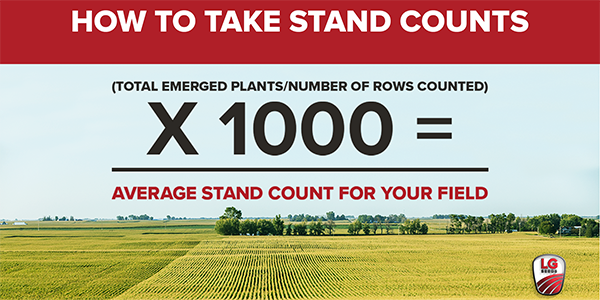AGRONOMICSUPPORT
YOU CAN TAKETO THE FIELD
Making it Count: Evaluate Your Crop by Taking Reliable Stand Counts
Mother Nature has her own playbook, and she’s not shy about throwing curveballs.
Whether you’re ahead of schedule or dealing with delays, one thing remains constant: the need to get boots on the ground and evaluate crop emergence. Taking stand counts is the most direct way to understand how your crop is performing early in the season and to guide crucial decisions like replanting.
Why Stand Counts Matter
Stand counts are more than just numbers, they provide early-season insight into crop health, uniformity, and potential yield. They help identify problems like uneven emergence, planter malfunctions, or pest and weather-related setbacks. Done right, they inform replant decisions that can significantly impact ROI.
If you want to check corn emergence and stand count after planting, knowing how to do it accurately is essential.
How to Take Reliable Stand Counts
The standard approach used by most agronomists is the 1/1000th acre method. It’s quick, repeatable, and accurate enough for practical in-field decisions.
Step-by-step:
Gather tools: tape measure, clicker counter or phone app, notepad.
Pick a representative spot in the field, not just the good areas.
Measure row length based on spacing:
30” rows = 17’5”
15” rows = 34’10”
Count emerged plants in that length. Count the rows on both sides of the tape, calculate the average, and use that to estimate plant population.
Multiply by 1,000 to get plants per acre.
Repeat in 5-6 spots across the field and average the results.
Use a chart or calculator to adjust for different row widths. And if you want more advanced options, tools like drones, counting apps, or the hoop and wheel methods can complement your manual counts.
For a more in-depth breakdown, see our detailed guide on checking corn emergence and stand counts.
Interpreting Results: What Do Your Numbers Say?
A good rule of thumb: your actual stand should be at least 95% of your planted population. For instance, if you planted at 32,000 seeds/acre, you should see about 30,400 emerged plants.
If your average falls short:
Look for patterns or localized issues (planter skips, insect pressure, crusting).
Evaluate seedling health and growth uniformity.
Keep outlier counts separate for more focused assessment.
Understanding how stand counts fit into the broader picture of crop performance? Start with these key factors for achieving high corn yields.
What Can Go Wrong with Stand Establishment?
Several common factors can reduce emergence:
Cold, wet soils
Planting too early or too deep
Poor seed-to-soil contact
Insect feeding or disease pressure
To address these risks, check your planter calibration, monitor soil temps closely, and adjust residue management and planting speeds accordingly. Also, explore the importance of micronutrients in corn production, which can play a hidden but crucial role in emergence success.
Making Smart Replant Decisions
Replanting decisions should balance emergence data, seedling condition, and time of year. For example, corn planted in late April may hit optimal yield, while planting in late May could cut yield potential by 20%. Similar dynamics apply to soybeans.
Your LG Seeds agronomist can help assess the replant ROI, eligibility under seed replant programs, and hybrid-specific emergence expectations.
Ready to Get Started?
Evaluating your stand early in the season gives you critical insight—and confidence. Don't make these decisions alone. Consult with an LG Seeds agronomist for personalized stand count strategies to optimize emergence, improve uniformity, and protect your yield potential.
Also explore:






Agronomy Team